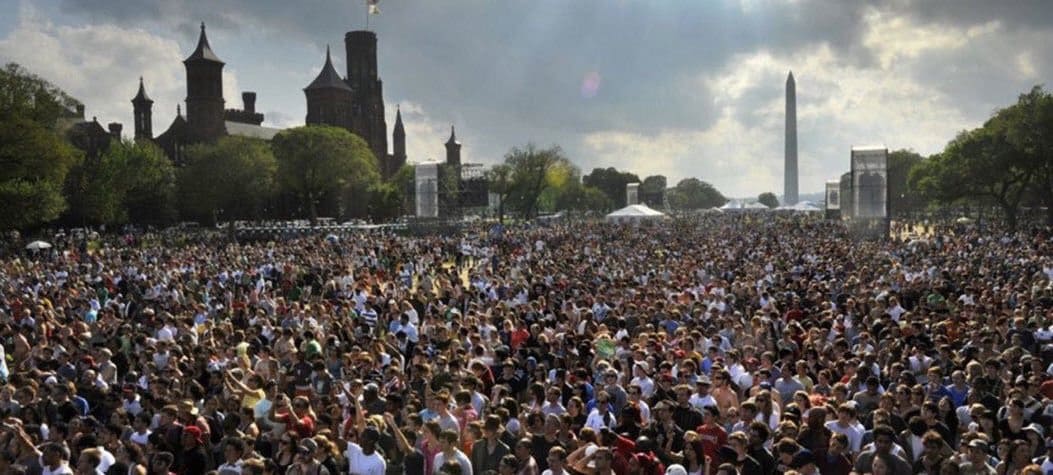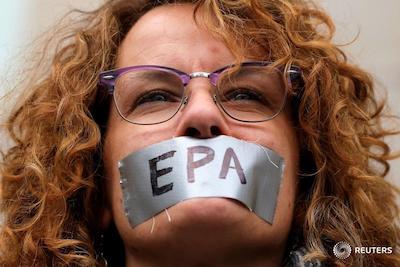Above: scenes from the DC Science March
Below: Text of EPA Alum Kathy Setian’s speech, delivered at the Science March in San Francisco on April 22nd.
Kathy Setian was a project manager at the U.S. Environmental Protection Agency and a Steward for Engineers and Scientists of California, IFPTE Local 20.
Thank you Kishore. As you mentioned, I was a project manager and engineer at EPA for 20 years. But before that, I worked in the tech industry. I left a higher paying corporate job for the higher honor of public service, protecting human health and the environment. I never regretted that decision. But now, everything my colleagues and I have worked for is at risk of being dismantled. That’s why I’m marching today.
EPA is in the cross-hairs, because we produce the analyses and solutions to problems that Washington won’t even admit to.
As federal scientists we work for the public interest, and here, organized labor has a critical role to play. EPA workers are here today thanks to their unions: Engineers and Scientists of California, NTEU and AFGE.
Today’s march brings together two powerful forces: dedicated scientists who investigate the real world, and activated citizens who demand application of that science to our most pressing problems. We are all under attack.
It starts with the budget. For example, at EPA, the Trump administration wants to cut thousands of jobs and slash funding by almost a third.
Is this a good way to save money? EPA’s budget is tiny. The average tax payer pays only $26 a year for EPA, compared to thousands per year on the military.
And investments in environmental protection pay huge dividends. Every dollar spent preventing air pollution would save $30 in future health care costs, according to a 2011 study.
So how do we protect ourselves?
Protection of Human Health & the Environment requires a strong EPA and strong environmental rules.
Environmental rules are created, defended and expanded by demand of a mobilized public.
For example, in 1969 a Cleveland river caught fire due to unregulated dumping. And the Charles River in Boston was so polluted that you had to go to a hospital if you fell in.
These events gave birth to the Clean Water Act, now on the chopping block.
Or in 1978, when residents in Love Canal had to be evacuated. Chemicals linked to cancer and birth defects had been buried in leaking containers beneath their homes. This and other outrages led to the
Superfund Law which requires polluters to cleanup contamination. Also on the chopping block.
Or in 1984, when Union Carbide released a poisonous gas in Bhopal India. Hundreds of thousands of people were killed or injured. Worldwide outrage forced our Congress to enact community right-to-know laws, which made decades of chemical data publicly available. Another law now on the chopping block.
BUT WAIT, THERE’S MORE: Pollution does not affect everyone equally. Who’s hit the hardest? Children under 5 suffer most of the disease from dirty air. Also hit hard are the poorest people and minorities.
And EPA’s office of Environmental Justice? Targeted for closure.
If environmental rules protect health and save money in the long term, why are they being attacked?
To understand we need to enter the realm of smoke and mirrors.
It is a Myth that Environmental Rules Kill Jobs.
The facts prove otherwise. Between 1990 and 2012, we greatly reduced pollutants while doubling the GDP. Economic growth and environmental rules can exist side by side.
We support retraining for workers who have lost jobs and real income over the past several decades. Worldwide, green energy production is poised to spawn a multi-trillion dollar industry, and create thousands of jobs. But U.S. workers won’t benefit from the green economy if our leaders stubbornly cling to coal and climate denial.
It is also a myth that EPA funds could be better spent by the states. Pollution does not stop at state boundaries. It requires consistent federal regulation. And the states alone don’t have the technical capacity. For example, in 2014 the city of Toledo wondered why their water supply was turning green. They consulted EPA scientists who were able to identify a rare liver toxin.
With all these myths, what are the real reasons why EPA and other science agencies are under attack?
Today corporate profiteers are in positions of power to dismantle environmental protections.
The pursuit of profit leads corporations down pathways that might be quicker and cheaper in the short term, at the expense of public health and safety. The very definition of greed.
And today the captains of industry rule.
EPA chief Scott Pruitt worked closely with Oklahoma gas and oil companies such as Devon Energy; their opposition to EPA methane rules were cut-and-pasted directly onto Oklahoma State letterhead.
They want to hoodwink Americans into thinking unregulated industry will not pollute; and that climate change is not real.
But in order to do so, they must attack real evidence to the contrary. Ignorance is dangerous, and a threat to democracy itself.
Because we scientists produce the facts that expose the lies currently being purveyed, the tip of the spear is pointed at us. Galileo, the father of the scientific method, and survivor of the Inquisition, would probably agree that science is not political, but sometimes politicians come gunning for scientists. That’s why scientists need unions: for a workplace free from fear of corporate influence that corrupts policy debates.
It is time for scientists and informed citizens to decide our own priorities. Our lives and livelihood depend on it. We are marching to defend and expand our hard-won protections; and in solidarity with others who remain resolved and organized against these threats.

